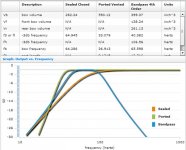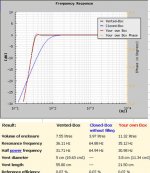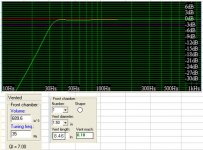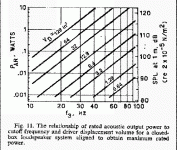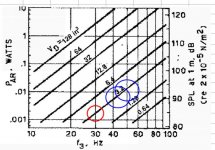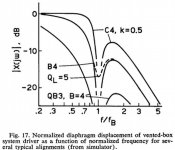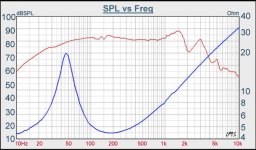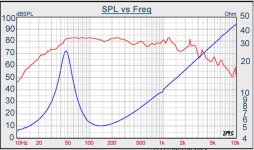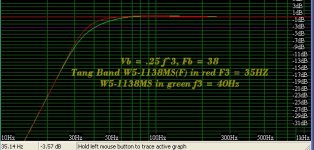Ok you guys convinced me! did a re-design now a 13" X 8" box using the Tang Band W5-1138, 40, Watt RMS/60 Watt max, 85.6 dB 1W/1m, Vas 0.17 ft^3
here is the results.
They will exceed the PP point with these!
These will give over 100 db SPL with about 30 watts.
33 Hz is only about -1 db, the F3 point is about 30 HZ depending on the software.
I think these are better, Thanks
Now for the crossover
here is the results.
They will exceed the PP point with these!
These will give over 100 db SPL with about 30 watts.
33 Hz is only about -1 db, the F3 point is about 30 HZ depending on the software.
I think these are better, Thanks
Now for the crossover
Attachments
I will be crossing it over to the Vifa D27TG35-06 1" Silk Dome Tweeter at 1k to 1500. could start cutting the 1138 earlier to compensation for it's peaking between 1 & 2k. Do you have experience with either of these? All I know is what I read.
A mod to improve the tweeter
http://www.raylectronics.nl/pdfs/Modifying_Vifa_tweeter.pdf
A mod to improve the tweeter
http://www.raylectronics.nl/pdfs/Modifying_Vifa_tweeter.pdf
Last edited:
I just wanted to thank the folks that posted this crossover tutorial. amazing amount of knowledge. If anyone has not read this already they should.
http://www.diyaudio.com/forums/mult...designing-crossovers-without-measurement.html
http://www.diyaudio.com/forums/mult...designing-crossovers-without-measurement.html
FWButler:
I would tune the speaker a little higher-about 45 Hz, which is its Fs. The Qts of 0.45 is only a little higher than the ideal Qts of 0.38 for a maximally flat system.
Even more important is the excursion. The following is a chart by Richard Small for the amount of air required to be moved to produce a given low frequency at a given SPL. I converted his metric numbers to inches.For a reflex box, you can divide this number by four.
Your TangBand speaker has a cone area of 3.6 in²-I converted from metric. The excursion is listed at 9.5mm-I assume that is one way, (P-P). The chart applies to midpoint-to-peak excursion, so we divide that by half. That is about 5mm-about 0.2in. Still a very good excursion for that size speaker.
So the total amount of air this speaker can move, in square inches, is 0.72in. Again, if you use it in a reflex, it only has to move ¼ the air listed.
I would tune the speaker a little higher-about 45 Hz, which is its Fs. The Qts of 0.45 is only a little higher than the ideal Qts of 0.38 for a maximally flat system.
Even more important is the excursion. The following is a chart by Richard Small for the amount of air required to be moved to produce a given low frequency at a given SPL. I converted his metric numbers to inches.For a reflex box, you can divide this number by four.
Your TangBand speaker has a cone area of 3.6 in²-I converted from metric. The excursion is listed at 9.5mm-I assume that is one way, (P-P). The chart applies to midpoint-to-peak excursion, so we divide that by half. That is about 5mm-about 0.2in. Still a very good excursion for that size speaker.
So the total amount of air this speaker can move, in square inches, is 0.72in. Again, if you use it in a reflex, it only has to move ¼ the air listed.
Attachments
If you put your speaker in a reflex box you can multiply your displacement by 4, since a reflex reduces the excursion at the tuning point by that amount. 0.72in² times 4 = 2.9. Close enough to 3.2in².
If you extrapolate the chart between 40 Hz and 50 Hz, you can see that 3.2 in² gets you about 92 dB at 45 Hz before your excursion limit is reached.
To put this into perspective, the lowest tuning on a bass guitar, (normal tuning), is 42 Hz. That's usually the lower limit for most popular music, and you are just about at that point. Also consider that most professional DJ's use speakers that go down to 60 Hz or so. That's good enough for dances, etc. You'll be going down lower, though of course not as loud, as those pro speakers.
That is what I would suggest for getting the best, cleanest bass without running the risk of damaging your speakers by driving them into overexcursion. I would also suggest that you make the cubic volume of your speaker the same as the Vas, 0.21 ft.³ . You'll get a very, very small hump in the response, but nothing to worry about.
If you extrapolate the chart between 40 Hz and 50 Hz, you can see that 3.2 in² gets you about 92 dB at 45 Hz before your excursion limit is reached.
To put this into perspective, the lowest tuning on a bass guitar, (normal tuning), is 42 Hz. That's usually the lower limit for most popular music, and you are just about at that point. Also consider that most professional DJ's use speakers that go down to 60 Hz or so. That's good enough for dances, etc. You'll be going down lower, though of course not as loud, as those pro speakers.
That is what I would suggest for getting the best, cleanest bass without running the risk of damaging your speakers by driving them into overexcursion. I would also suggest that you make the cubic volume of your speaker the same as the Vas, 0.21 ft.³ . You'll get a very, very small hump in the response, but nothing to worry about.
Thanks kelticwizard. I was just reading Small Vented-box Loudspeaker...part 2, trying to make since of equation (41) Par(Vb) = 3.0 f3^4 Vd^2 trying to make sure that 90 db, after what the others have said, would not bottom out the speakers. Your evaluative comments are of great help. you have sent me back to figuring.
Yes-go from the red circle to one of the blue ones.
I admire a man who makes it easy to answer the question.
Qts is the total Q of the woofer you are starting with, free air. It is 0.43 instead of 0.45? So much the better.
Thiele-Small's original work call for a speaker with free air Qts of 0.38, (usually shortened to 0.4 in the real world, Qts is not that exacting). Put it in a box equal to the Vas, and it will be maximally flat down to the drivers free air resonance frequency, Fs.
So the ideal would be:
Qts = 0.38, (or 0.4)
Vb, (box volume, internal) = Vas
Fb, (frequency of box tuning) = F3
-3 dB down point = F3
That is the "classic bass reflex" Thiele-Small came up with-they came up with others too, but that is the first one. Your speaker and your projected box size is very very close to that.
I admire a man who makes it easy to answer the question.
Qts is the total Q of the woofer you are starting with, free air. It is 0.43 instead of 0.45? So much the better.
Thiele-Small's original work call for a speaker with free air Qts of 0.38, (usually shortened to 0.4 in the real world, Qts is not that exacting). Put it in a box equal to the Vas, and it will be maximally flat down to the drivers free air resonance frequency, Fs.
So the ideal would be:
Qts = 0.38, (or 0.4)
Vb, (box volume, internal) = Vas
Fb, (frequency of box tuning) = F3
-3 dB down point = F3
That is the "classic bass reflex" Thiele-Small came up with-they came up with others too, but that is the first one. Your speaker and your projected box size is very very close to that.
Okay,gotta go for a half hour or so, but yes, alignment vs displacement.
Theoretically a driver with a free air Qts above 0.38 requires a box larger than Vas and a tuning frequency above Fs. However, your alignment is so close to the classic bass reflex, you are only off by a little, that you can fudge it with no problem. And your F3 and box size will be about what you were aiming for.
Theoretically a driver with a free air Qts above 0.38 requires a box larger than Vas and a tuning frequency above Fs. However, your alignment is so close to the classic bass reflex, you are only off by a little, that you can fudge it with no problem. And your F3 and box size will be about what you were aiming for.
I do not understand your comments about the Qts? the TB1138 has a Qts of 0.43. do you mean a desired Qtc?
Qts = Free air total Q of driver
Qtc = Total Q of driver in closed box.
We are doing bass reflex, also known as ported. We don't have to worry about Qtc.
To find the response curve of a ported box, we only deal with:
Qts
Fs, (free air resonance)
Vas, (definition is not important, just remember it is given in cubic measure)
Vb, (volume of air in the box)
Fb, (frequency box is tuned to via port)
F3, (-3 dB down point)
Just for the record, Qtc= [sq rt (Vas/Vb) + 1] times Qts
But like I said, that is stuff useful for closed box calculations.
Not to overload, but I checked out the frequency response of the TangBand 1138 at their website. Pretty smooth up to 1,000 Hz, but there's peak around 1,500 Hz.
http://www.tb-speaker.com/detail/1208_03/w5-1138sm.htm
http://www.tb-speaker.com/detail/1208_03/w5-1138sm.htm
Attachments
LOL, the different listed parameters might just be the variation from speaker to speaker.
Bass wise, the two speakers seem to be within 1 dB of each other in the bottom half octave. That's really close.
The F speaker seems to have cone breakup between 1,000 Hz and 2,000 Hz as well, but nowhere near as radical especially if you want to crossover at 1,500 Hz.
If you tune either speaker to 45, you'll get a slight bump from 45-90 Hz, but it won't be large. Speaker excursion is smallest at the tuning point, (Fb), and for excursion reasons I really don't think these small speakers should be driven below 45 Hz or so. But it's up to you.
Bass wise, the two speakers seem to be within 1 dB of each other in the bottom half octave. That's really close.
The F speaker seems to have cone breakup between 1,000 Hz and 2,000 Hz as well, but nowhere near as radical especially if you want to crossover at 1,500 Hz.
If you tune either speaker to 45, you'll get a slight bump from 45-90 Hz, but it won't be large. Speaker excursion is smallest at the tuning point, (Fb), and for excursion reasons I really don't think these small speakers should be driven below 45 Hz or so. But it's up to you.
Just taking a guess, the SMF version of this speaker looks like it might be intended for someone who wants to cross over higher than in the SM version.
If I could hazard a guess, the F might stand for "full range". It isn't full range of course, but the response curve for the F looks like it is more useful for someone wanting to cross over higher.
If I could hazard a guess, the F might stand for "full range". It isn't full range of course, but the response curve for the F looks like it is more useful for someone wanting to cross over higher.
- Status
- This old topic is closed. If you want to reopen this topic, contact a moderator using the "Report Post" button.
- Home
- Loudspeakers
- Multi-Way
- 30 HZ from a 10 X 7 box
